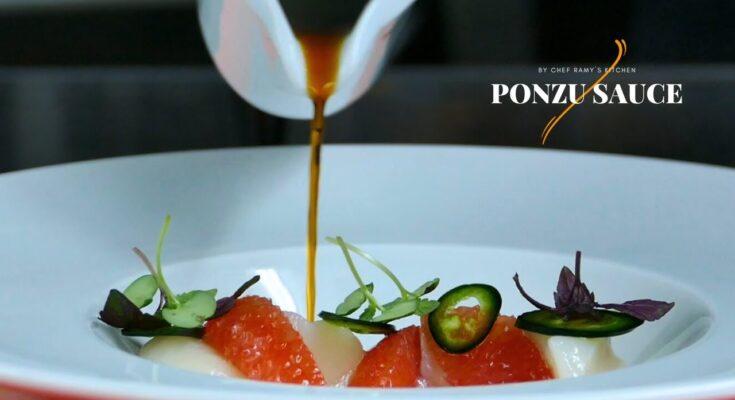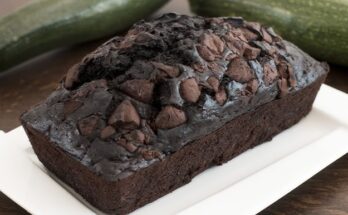Ponzu Sauce Recipe: If you’ve ever dipped sushi into a tangy, slightly sweet, and deeply umami sauce, chances are you’ve tasted ponzu. This Japanese condiment brings together the perfect harmony of citrus, soy sauce, and savory depth that’s hard to resist.
Let’s dive into a simple yet authentic ponzu sauce recipe that you can whip up at home in no time. Whether you’re a home cook or a culinary adventurer, this guide will walk you through each step to creating the perfect homemade ponzu sauce.
Introduction to Ponzu Sauce
So, what exactly is ponzu sauce? Ponzu is a citrus-based sauce commonly used in Japanese cuisine. It’s known for its vibrant balance of salty, sour, and slightly sweet notes, often made with ingredients like soy sauce, citrus juice (like yuzu, lemon, or lime), mirin, and rice vinegar.
The term “ponzu” actually stems from the Dutch word pons, meaning punch (as in fruit punch), which reflects its citrus roots. Originally developed centuries ago, ponzu has become a staple in Japanese households and restaurants alike, particularly as a dip for sashimi, dumplings, and grilled meats.
Its flavor is incredibly versatile. The tangy citrus cuts through the saltiness of soy sauce, while mirin adds a hint of sweetness. Dashi or bonito flakes give it that rich umami backbone. The result? A complex, flavorful sauce that can elevate even the simplest dish.
Why Make Ponzu Sauce at Home?
Sure, you can buy a bottle of ponzu sauce at the store. But homemade ponzu sauce? That’s a whole other experience. Here’s why you should make it yourself:
- Healthier Ingredients: Store-bought ponzu often contains preservatives, artificial flavors, or excessive sodium. When you make it at home, you control what goes in.
- Custom Flavor: Want it tangier? Add more citrus. Less salty? Reduce the soy sauce. You can tweak it to suit your palate perfectly.
- Budget-Friendly: Ponzu isn’t the cheapest sauce on the shelf. Homemade versions not only save money in the long run but also offer more yield.
- No Additives: Clean, natural ingredients mean your ponzu sauce is not only delicious but also free from unnecessary chemicals.
Making ponzu sauce from scratch gives you creative control. Plus, there’s something incredibly satisfying about preparing your own sauce—it’s fresher, more aromatic, and often far superior in taste.
Ingredients Needed for Ponzu Sauce
To make a traditional ponzu sauce, you don’t need a laundry list of ingredients—just the right ones. Here’s what you’ll need:
Basic Ingredients:
- Soy Sauce: This is the base of the sauce. Opt for a low-sodium version if you prefer less salt.
- Citrus Juice: Yuzu is traditional, but since it’s rare outside Japan, you can substitute with lemon, lime, or even a mix of both.
- Mirin: A sweet Japanese rice wine that adds complexity and a slight sweetness.
- Rice Vinegar: Offers a mild tang and enhances the citrus flavor.
- Bonito Flakes or Dashi: Adds umami depth. You can use kombu (seaweed) for a vegetarian version.
Optional Add-Ins:
- Orange zest or juice for a sweeter, fragrant touch
- Garlic or ginger for a spicier kick
- Chili flakes if you like it hot
Tips for Choosing Ingredients:
- Fresh citrus juice always beats bottled.
- High-quality soy sauce really makes a difference—go for naturally brewed.
- Bonito flakes should be fresh and aromatic, not overly fishy.
By carefully selecting your ingredients, you ensure that your ponzu sauce tastes fresh, balanced, and authentic.
Tools and Utensils Required
Before you start, make sure you’ve got all the right tools on hand. Nothing fancy, just the basics to make your process smooth and easy:
Essential Tools:
- Mixing Bowl: To combine all ingredients.
- Measuring Cups & Spoons: Precision matters when balancing flavors.
- Strainer or Cheesecloth: To strain out the bonito flakes or kombu.
- Airtight Glass Jar: For storing your ponzu sauce in the fridge.
- Citrus Juicer: Helps extract juice without the pulp or seeds.
Helpful Tips:
- Sterilize your jar before use to prolong the shelf life of your sauce.
- Use non-metallic bowls (like glass or ceramic) to avoid any acidic reaction from the citrus.
- Prepare your mise en place: having everything ready makes the process faster and more enjoyable.
Once you have all your tools lined up, you’re just a few simple steps away from homemade ponzu bliss.
Step-by-Step Guide to Making Ponzu Sauce
Now the fun part—making the sauce! Follow these simple steps to whip up your own batch of ponzu sauce that’s packed with authentic flavor.
Step 1: Gather All Ingredients
Start by measuring out all your ingredients. This makes the mixing process seamless and ensures your ratios are spot-on. Freshness is key here, especially when it comes to citrus and dashi ingredients.
Step 2: Combine Ingredients in a Bowl
In a medium-sized bowl, mix:
- ½ cup soy sauce
- ¼ cup fresh citrus juice (lemon, lime, or a combo)
- 2 tbsp mirin
- 1 tbsp rice vinegar
- 1 tbsp bonito flakes or a small piece of kombu
Give it a good stir so everything blends nicely.
Step 3: Let It Rest and Infuse
Cover the bowl with a clean towel or wrap and let it sit at room temperature for 4-6 hours. This resting period allows the flavors to mingle and deepen.
For an even richer taste, refrigerate the mixture overnight.
Step 4: Strain and Store
Strain the mixture through a fine mesh strainer or cheesecloth to remove any solids. Pour your sauce into a sterilized glass jar or bottle. Store in the fridge and use within two weeks for optimal flavor.
Tips for the Best Ponzu Sauce
Homemade ponzu sauce can go from great to incredible with just a few simple tweaks. Whether you’re making it for dipping dumplings or drizzling over a poke bowl, here are some tips to ensure you nail it every single time:
1. Taste As You Go
Don’t be afraid to tweak the ratios. Too salty? Add more citrus or a splash of water. Too sour? A touch more mirin or even a pinch of sugar can balance it out. It’s all about tailoring the flavor to your taste buds.
2. Use Fresh Citrus
Bottled lemon or lime juice just won’t cut it. Fresh juice offers a brightness that’s essential to that zingy, refreshing kick ponzu is known for. For a citrusy boost, add a bit of zest to your mix before straining.
3. Let It Rest
We mentioned this earlier, but it bears repeating—rest time is key. Just like a good stew or marinade, the flavor of ponzu sauce improves as it sits. The umami from bonito or kombu needs time to develop and harmonize with the acidity of the citrus and the saltiness of the soy.
4. Strain Carefully
Nobody wants soggy bonito flakes or chunks of citrus pulp in their dipping sauce. Use a fine-mesh sieve or cheesecloth to get a clear, smooth sauce that’s ready to serve.
5. Store It Properly
Always keep your ponzu sauce in a tightly sealed container in the refrigerator. This not only maintains freshness but also prevents the flavors from becoming overly pungent or bitter.
By following these tips, you’ll consistently create ponzu sauce that rivals the best Japanese restaurants. And the best part? It’s yours—custom-made with your flavor preferences in mind.
Creative Variations of Ponzu Sauce
The beauty of homemade ponzu is how adaptable it is. Depending on the dish you’re serving or your dietary needs, you can switch things up and still get a killer sauce. Here are a few tasty variations to try out:
Spicy Ponzu Sauce
Add a kick by incorporating a bit of:
- Chili oil
- Sriracha
- Red pepper flakes This version is perfect for grilled meats or as a spicy dipping sauce for dumplings.
Citrus-Heavy Ponzu
If you’re really into those tart, refreshing vibes, up the citrus factor. Use more lemon or lime juice, and maybe even add a splash of orange juice or yuzu if you can find it. This variation works beautifully with salads or sashimi.
Sweet Ponzu Sauce
For something milder and kid-friendly, reduce the vinegar and boost the mirin. You can also add a small spoon of honey or maple syrup. It pairs great with stir-fried veggies or chicken.
Vegan or Gluten-Free Ponzu
- Vegan: Skip the bonito flakes and use dried shiitake mushrooms or kombu for umami.
- Gluten-Free: Use tamari instead of traditional soy sauce. These swaps still keep the core flavor while catering to dietary restrictions.
Don’t be afraid to experiment. Ponzu is incredibly forgiving, and once you’ve mastered the basics, the variations are endless.
How to Store Ponzu Sauce
Proper storage makes all the difference when it comes to preserving flavor and freshness. Let’s break it down so your homemade ponzu lasts as long as possible:
Best Containers for Storage
Glass jars with tight-sealing lids are your best bet. Avoid plastic containers, as they can absorb flavors and odors. A small mason jar or recycled glass bottle with a screw top works perfectly.
Refrigeration is Key
Always refrigerate your ponzu sauce. Even though the vinegar and citrus help preserve it naturally, keeping it chilled will maintain its taste and prevent spoilage.
Shelf Life of Homemade Ponzu
- Refrigerated: 1 to 2 weeks
- With alcohol (like sake): Up to 3 weeks If you’ve added fresh ingredients like garlic, use it within 10 days for peak flavor.
Signs Your Ponzu Has Gone Bad
- Foul or sour smell (different from citrusy tang)
- Cloudiness or mold in the jar
- Off taste that’s bitter or overly acidic
Storing it right ensures that every time you open that jar, the sauce tastes just as fresh and flavorful as the day you made it.
Serving Suggestions
Ponzu sauce is insanely versatile—it’s not just a dipping sauce! Here’s how to get the most out of every delicious drop:
As a Dip
- Sushi and sashimi
- Gyoza or potstickers
- Tempura It’s the perfect balance to fried or rich foods.
As a Marinade
Ponzu works wonders as a marinade for:
- Grilled chicken or beef
- Fish like salmon or tuna
- Tofu or tempeh The acidity tenderizes proteins while adding bright, bold flavor.
As a Salad Dressing
Mix ponzu with a splash of olive oil or sesame oil for a quick, zesty salad dressing. It’s fantastic on seaweed salads, cucumber salads, or even cold soba noodles.
Unique Ideas
- Drizzle over roasted vegetables
- Use as a topping for grain bowls
- Stir into soups or broths for a flavor boost
Once you get creative with ponzu, you’ll realize it belongs in more dishes than you ever imagined.
Health Benefits of Ponzu Sauce
Ponzu isn’t just tasty—it can actually be a healthier option compared to other sauces. Here’s why:
Lower in Sugar
Many dipping sauces and marinades are packed with sugar. Ponzu, especially homemade, has much less (or none at all), depending on how you prepare it.
Naturally Low in Calories
A typical serving of ponzu contains fewer calories than creamy dressings or thick sauces. That makes it a smart choice for those watching their weight or eating clean.
Rich in Umami
Umami not only makes food taste better, but it can also help you feel more satisfied with smaller portions. That’s a win if you’re trying to cut down on snacking.
Packed with Antioxidants
Citrus juice brings in a healthy dose of vitamin C and antioxidants, which support your immune system and help fight inflammation.
Customizable for Dietary Needs
- Gluten-free? Use tamari.
- Vegan? Ditch the bonito and go for kombu or mushrooms. Ponzu adapts to your health goals while still keeping the flavor on point.
Common Mistakes to Avoid
Even though ponzu sauce is simple to make, there are a few common pitfalls that can affect the final taste. Let’s go over them so you can skip the learning curve and make a flawless batch every time:
1. Overpowering with Citrus
Citrus is key, but too much can dominate the sauce. You want balance, not a lemon explosion. Stick to the ratio guidelines and adjust gradually to find the sweet (and sour) spot.
2. Using Low-Quality Soy Sauce
The flavor of your soy sauce sets the foundation. A poor-quality or overly salty soy sauce will ruin the balance. Choose naturally brewed soy sauce for a smooth, rich umami flavor.
3. Skipping the Resting Time
Ponzu isn’t a mix-and-serve kind of sauce. The ingredients need time to infuse and develop that layered flavor. Skipping the resting time leads to a flat, underwhelming taste.
4. Forgetting to Strain
Leaving bonito flakes, kombu, or citrus pulp in the sauce can make it gritty or overly fishy. Always strain the sauce before bottling it to maintain a clean, fresh flavor.
5. Not Tasting Before Storing
Before sealing it in a jar, give it a final taste. Need more acid? Add a splash of vinegar. Too salty? Dilute slightly with citrus juice or filtered water. Fine-tuning now ensures the best flavor later.
By steering clear of these mistakes, you’re already on your way to making ponzu sauce like a seasoned pro.
FAQs about Ponzu Sauce Recipe
What is ponzu sauce?
Ponzu sauce is a tangy, citrus-based sauce commonly used in Japanese cuisine. It blends soy sauce, citrus juice (like yuzu, lemon, or lime), mirin, and often a dash of vinegar. This versatile sauce adds a zestful kick to dishes like sashimi, salads, and grilled meats.
How do I make homemade ponzu sauce?
Homemade ponzu sauce is surprisingly simple to whip up! You’ll need:
- 1/2 cup soy sauce
- 1/4 cup citrus juice (yuzu is traditional, but lemon or lime works well)
- 2 tablespoons mirin
- 1 tablespoon rice vinegar
- Optional: katsuobushi (dried bonito flakes) or a piece of kombu for depth
Mix all ingredients and let the mixture sit for a few hours or overnight to meld the flavors. Strain before using for a clearer sauce.
Can I substitute lemon for yuzu in ponzu sauce?
Absolutely! While yuzu has a unique flavor, lemons make a great substitute and are much easier to find. You might also experiment with other citrus fruits like lime or orange to tweak the flavor profile.
Is ponzu sauce vegan?
Traditional ponzu sauce includes katsuobushi (dried bonito flakes), which are not vegan. However, you can make a vegan version by omitting the bonito flakes or using a seaweed-only base with kombu. Check your soy sauce and mirin labels to ensure they’re free from animal-derived ingredients.
How long can I store homemade ponzu sauce?
Homemade ponzu sauce can be stored in the refrigerator for up to a week. For longer storage, ensure it’s kept in a tightly sealed container. The flavor may deepen over time, so give it a taste before use to see if it fits your dish.
What are some popular dishes to use ponzu sauce with?
Ponzu sauce shines when used with cold dishes like salads and sashimi but don’t hold back on experimenting! It’s also excellent as a marinade for grilled meats, drizzled over steamed vegetables, or as a dipping sauce for dumplings.
Conclusion
Ponzu sauce is one of those magical ingredients that can elevate nearly any dish. Whether you’re dipping sushi, marinating steak, or jazzing up a salad, this citrusy, savory sauce adds depth and zing like nothing else.
Making it at home lets you control the ingredients, tweak the flavors, and create something uniquely yours. It’s easy, budget-friendly, and so much fresher than anything you’ll find on the shelf.
So, go ahead—grab those lemons, soy sauce, and a jar. Once you make your own ponzu, you’ll never want to go back to store-bought again.



